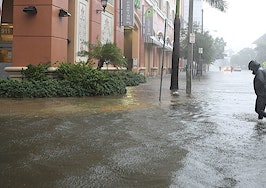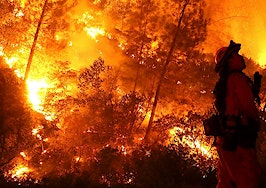Jeff Michael spent last Christmas hunting for homeowner’s insurance.
Michael, an economist at the University of the Pacific, told Inman that when he bought his home in a rugged corner of Northern California a decade ago, his policy cost him about $1,000 per year. Then prices kept rising and rising.
“Seven years later I was at $3,000,” he recalled.

Jeff Michael
Then finally, in late 2018, his insurance company dropped him altogether. After an intensive search for a new provider — which stretched through last year’s holiday season — Michael finally found a new firm, Lloyds of London, that would insure his house for about $5,000 per year. And he considers himself lucky.
“Since then, the new thing in 2019 is people not getting renewed by Lloyds,” he said. “That’s definitely creating issues.”
The problem for Michaels’ and his neighbors is twofold: first, they live in an area prone to massive, community-obliterating wildfires; and second, climate change is making the risks much greater. The result is a long-running struggle among homeowners to get insurance — a situation the Sacramento Bee recently dubbed a “crisis” that has become a drag on the local real estate market.
California is an extreme example, coming as it is off of a year of record-breaking wildfires that among other things burned the tony hills near Malibu and Calabasas, as well as all but wiped the town of Paradise off the map.
But the problem is much, much bigger than just one state or one type of disaster. Much of the Eastern Seaboard faces flooding and rising sea levels. Hurricanes threaten the Gulf Coast. And just this year swollen rivers inundated the Midwest, leaving hundreds of homes destroyed and several people dead.
In each case, these are natural phenomena made worse by climate change, and which are making it considerably more expensive, or even impossible, to get homeowners insurance in the places where it’s needed most.

Homes destroyed by the Camp Fire on Feb. 11, 2019 in Paradise, California. | Credit: Justin Sullivan and Getty Images
The severity of this problem became particularly acute during and after Hurricane Harvey, which slammed into Texas in August of 2017. Though the storm swept across a highly populated area that included Houston, only 17 percent of the people in the most directly affected counties had flood insurance, according to an analysis at the time from the Washington Post.
Homeowners living in high-risk flood zones are actually required to get flood insurance in order to obtain a mortgage.

Larry Larson
However, Larry Larson — an engineer, policy advisor and founding member of the Association of State Floodplain managers — told Inman that many people living in flood zones don’t have mortgages on their property, and as a result lack insurance altogether.
He estimated that insurance coverage in U.S. flood zones is somewhere between 30 percent and 50 percent, with the numbers likely higher in newer developments but low in communities of more modest means.
Unlike the case with wildfires, where homeowners turn to the open market, the federal government runs the National Flood Insurance Program (NFIP) to provide homeowners coverage. Larson said rates vary, but currently average about $800 per year.

An upscale neighborhood in Houston, Texas, that flooded in the aftermath of Hurricane Harvey. | Credit: Jim Dalrymple II
But there are many issues with this program — which was described as “broken” in the wake of Hurricane Harvey — and rates are likely to go up soon. That’s because lawmakers are required to periodically reauthorize the program, and the U.S. House version.
The reauthorization allows for insurance rate increases of 18 percent per year for primary residences. Rates could jump even more on secondary homes. Larson said the U.S. Senate version of the new flood insurance program would allow smaller rate increases of 9 percent, and that he expects the final number to fall somewhere in the middle. The deadline to approve the program is coming up on Sept. 30.
Ultimately, NFIP and the ongoing efforts to reform it are complex and wonky.
But the take away here is fairly simple: Homeowners living in areas affected by climate change-fueled natural disasters are facing the prospect of steadily escalating insurance costs.
That makes the situation a kind of watery analogue to what Michael and his fellow Californians are experiencing, and hints at just how big the challenge is; Americans literally from coast to coast are paying more to protect their homes from climate change.
And in the case of flooding, the federal government itself is framing the issue in direct response to recent disasters — which scientists have linked to climate change.
“The level of damage from recent catastrophic storms makes it clear that FEMA needs a holistic plan to ready the nation for managing the cost of catastrophic flooding under the NFIP,” the Federal Emergency Management agency said in a recent statement.

A flooded Houston neighborhood after Hurricane Harvey | Credit: Jim Dalrymple II
Despite these challenges, millions of Americans continue to live in areas that could be affected by climate change. A recent analysis from Zillow, for example, found that there are nearly half a million homes just in high and very high wildfire risk zones in California alone. That amounts to nearly 5 percent of the state’s overall housing stock — a staggering number considering California is the most populous state in the U.S.
A report from scientific advocacy group Climate Central, out last week, identified a similarly alarming situation regarding flooding. The report revealed that in general housing is being built faster in flood zones than non-flood zones in a third of coastal states.
Collectively, New Jersey, Florida, and North Carolina have built more than 9,000 new homes in flood risk zones since 2010. And Delaware, Mississippi, New Jersey and Rhode Island are developing housing in flood zones at more than twice the rate they are building outside those areas.
The report adds that by 2100, “unchecked greenhouse gas emissions would expose 3.4 million existing homes worth $1.75 trillion to a 10 percent or higher annual risk of flooding.”
And that, in turn, could have devastating consequences both for individual homeowners and their broader communities.
“Across the United States, coastal communities have recently built tens of thousands of houses in areas at risk of future flooding driven by sea level rise from climate change,” the report states. “That has put homeowners, renters, and investors in danger of steep personal and financial losses in the years ahead.”






